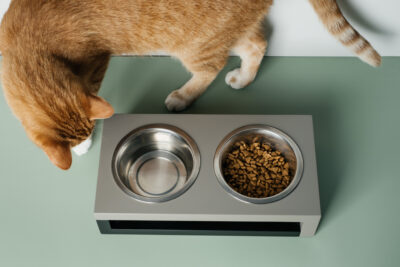Methimazole for Cats

Medication details
- Medication type: Antithyroid
- Form: Liquid, Tablet, Transdermal topical gel
- Prescription required? Yes
- FDA approved? Yes (Felimazole brand only)
- Life stage: All
- Brand names: Felimazole, Tapazole
- Common names: Methimazole, thiamazole
- Available dosages: Tablets: 1.25 mg, 2.5 mg, and 5 mg; Liquid: 2.5mg/ml, 5 mg/ml and 10 mg/ml; Transdermal compound varies
- Expiration range: Methimazole tablets are generally stable for two years. The stability of liquid and transdermal forms may vary; follow manufacturer recommendations.
Hyperthyroidism in cats is the most common endocrine disorder found in domestic cats, particularly older cats. It is most often diagnosed in senior felines ages 8 years and older.
Feline hyperthyroidism is nearly always caused by a benign (non-cancerous) tumor of the thyroid gland. While it can also be caused by cancerous thyroid tumors, thyroid carcinoma is far less common in cats.
In both cases, veterinarians may recommend the medication methimazole to manage hyperthyroidism in cats, alone or as part of a broader treatment plan.
What is Methimazole?

Methimazole is an antithyroid thioamide that inhibits the formation of thyroid hormones. It is used to treat hyperthyroidism in both humans and animals.
Methimazole is available in both brand name and generic formulations. Of the branded options, only the formulation that goes by the brand name Felimazole is FDA-approved to treat hyperthyroidism in cats. Felimazole was granted approval by the FDA in May, 2009.
Generic formulations of methimazole are considered extra-label, meaning they can be used at the discretion of your veterinarian.
Is Methimazole Safe for Cats?
Yes, methimazole is safe for adult cats, as long as they are not pregnant or nursing.
Methimazole is available for use in cats only with a prescription from your veterinarian. You can fill the prescription at a pharmacy or check with your veterinary clinic, as many keep methimazole in stock.
Because methimazole is also used in humans, it is generally widely available and inexpensive.
What Does Methimazole for Cats Look Like?

Methimazole comes in liquid and tablet format for oral administration, as well as a transdermal gel that can be applied to and absorbed by a cat’s skin.
Generic methimazole tablets are small, round, and white. There may be imprinted letters on the tablet. If there is a number imprinted on the tablet, it indicates the strength of the pill. Felimazole brand tablets are coated in a hard, shiny shell, which may be pink or orange, depending on the dose.
The transdermal formulation of methimazole is a viscous gel that may appear clear or translucent. It comes in a metered dispenser for more accurate dosing.
What Is Methimazole Used For in Cats?
Methimazole is used to treat hyperthyroidism in cats, which occurs when the thyroid gland is overactive and produces more thyroid hormones than a cat’s body needs.
Thyroid hormones are responsible for managing a cat’s metabolism, which is akin to the “energy engine” of the feline body. When thyroid hormone levels are elevated, it causes a cat’s body to run in “overdrive.” This imbalance puts a huge strain on a cat’s body and organs, which can cause severe illness, such as heart disease, and even death.

The most common symptom of hyperthyroidism reported by cat parents is weight loss despite an increase in appetite. Other signs of hyperthyroidism in cats include vomiting, increased thirst and urination, and changes in behavior. Your veterinarian may also notice a heart murmur, increased blood pressure, and enlargement of the thyroid gland.
How Does Methimazole Work?
Hyperthyroidism in cats is a progressive disease that requires lifelong management. As an antithyroid drug, Methimazole works by preventing the formation of thyroid hormones — specifically thyroxine (T4) and triiodothyronine (T3). This action is dose-dependent, so it can be adjusted to keep a cat’s thyroid hormones at the optimum level.
Unfortunately, over time, cats are likely to require more methimazole to manage their hyperthyroidism. Over many years, the medication may eventually become ineffective or require a dose so high that it causes unwanted side effects.
Although thyroid carcinoma is rare, cats treated for hyperthyroidism are at increased risk for developing the cancerous disease.
How to Give Methimazole to Cats

There are two different ways to give methimazole: by mouth (orally) and on the skin (transdermally).
- Tablets and liquids should be given by mouth every 12 hours. It is okay to hide the tablet in a small amount of food. Tablets should not be crushed because that can alter absorption. If your cat resists tablets and liquids, talk to your veterinarian about transdermal formulations.
- Transdermal gel should be given according to package instructions. The medication is typically applied to a hairless surface of your cat’s skin, such as the inner surface of the ear pinna (ear flap). Wear gloves when applying the medication. Alternate ears each dose and clean the other ear pinna with warm water and gentle soap to prevent build-up.
Methimazole for Cats: Side Effects
There are many possible side effects of methimazole that you may notice at home. These include:
- not eating (anorexia)
- vomiting
- weight loss
- weight gain
- itchiness (especially of the face)
- weakness
- lethargy
Cats are most likely to show signs of such side effects during the first month of treatment, and these often resolve over time.
Cats with gastrointestinal upset as a result of methimazole may tolerate transdermal formulations without side effects.
Changes to a cat’s organ function may also occur, including inflammation of the liver (hepatitis) and decrease in kidney function. Although it is rare, some cats can develop blood abnormalities when taking methimazole, in which case the medication should be discontinued.
Symptoms of Too Much Methimazole in Cats
It’s important to note that any side effects that may stem from giving your cat methimazole are not dose-dependent. That means that you cannot rely on symptoms of overdose to determine if your cat is taking too much of the drug.
Thyroid values should be monitored regularly by a veterinarian to make sure your cat’s dose is appropriate.
Reactions With Other Drugs and Medications

Administration of methimazole with phenobarbital or anticoagulant medications may decrease their efficacy. Some parasite preventatives should not be given with methimazole. Cats who are on some medications before starting methimazole may need to adjust their dose after their thyroid disease is controlled. These include theophylline, blood pressure medications, and certain heart medications.
Methimazole Dosage for Cats
Methimazole for cats is dosed based on individual response. Most cats are started on a low dose and increased slowly following serial blood testing of thyroid levels. The goal is to keep total thyroid hormone (T4) within the normal range. There is no defined maximum dose for methimazole in cats. However, if methimazole is not effective for your cat, your veterinarian may recommend alternative treatments.
What if My Cat Misses a Dose of Methimazole?
If your cat misses a dose of methimazole, give the next dose at the appropriate time. Do not double doses or give doses too close together to compensate for the missed dose.
If your cat misses a dose within 1 week of a planned thyroid level testing, alert your veterinarian as the missed dose may alter results.
Alternatives to Methimazole for Cats

If your cat develops side effects from methimazole or their disorder does not respond to the medication, talk to your veterinarian about alternative treatments for hyperthyroidism. These include:
I-131 radiotherapy – Injection of radioactive iodine that destroys the thyroid gland. This treatment is used in both humans and animals to cure hyperthyroidism.
Surgical thyroidectomy – Surgery to remove the enlarged thyroid gland, which eliminates the disease.
Iodine-free diet – Therapeutic diet for cats made without iodine and available by prescription only. This will not cure hyperthyroidism in cats, but can be used to manage the disease provided cats are restricted to a prescription, iodine-free diet only.
Cost of Methimazole for Cats
Generic methimazole tablets are inexpensive and can be purchased directly through your veterinarian or a prescription to a human pharmacy. A month of tablets will cost $5-50.
Liquid and transdermal formulations may be more expensive at $40-75 per month.
Methimazole Storage Instructions
Methimazole should be stored at room temperature, out of direct sunlight, in a sealed container unless otherwise specified by the manufacturer.









